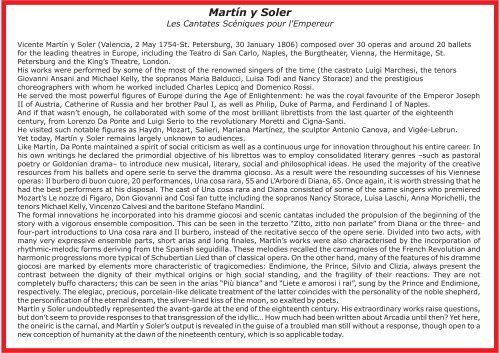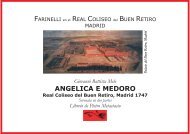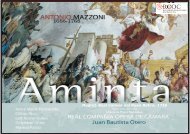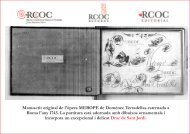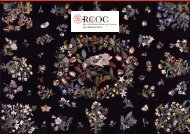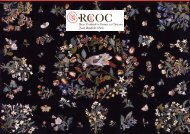Create successful ePaper yourself
Turn your PDF publications into a flip-book with our unique Google optimized e-Paper software.
Martín y Soler<br />
Les Cantates Scéniques pour l'Empereur<br />
Vicente Martín y Soler (Valencia, 2 May 1754-St. Petersburg, 30 January 1806) composed over 30 operas and around 20 ballets<br />
for the leading theatres in Europe, including the Teatro di San Carlo, Naples, the Burgtheater, Vienna, the Hermitage, St.<br />
Petersburg and the King’s Theatre, London.<br />
His works were performed by some of the most of the renowned singers of the time (the castrato Luigi Marchesi, the tenors<br />
Giovanni Ansani and Michael Kelly, the sopranos Maria Balducci, Luisa Todi and Nancy Storace) and the prestigious<br />
choreographers with whom he worked included Charles Lepicq and Domenico Rossi.<br />
He served the most powerful figures of Europe during the Age of Enlightenment: he was the royal favourite of the Emperor Joseph<br />
II of Austria, Catherine of Russia and her brother Paul I, as well as Philip, Duke of Parma, and Ferdinand I of Naples.<br />
And if that wasn’t enough, he collaborated with some of the most brilliant librettists from the last quarter of the eighteenth<br />
century, from Lorenzo Da Ponte and Luigi Serio to the revolutionary Moretti and Cigna-Santi.<br />
He visited such notable figures as Haydn, Mozart, Salieri, Mariana Martínez, the sculptor Antonio Canova, and Vigée-Lebrun.<br />
Yet today, Martín y Soler remains largely unknown to audiences.<br />
Like Martín, Da Ponte maintained a spirit of social criticism as well as a continuous urge for innovation throughout his entire career. In<br />
his own writings he declared the primordial objective of his librettos was to employ consolidated literary genres –such as pastoral<br />
poetry or Goldonian drama– to introduce new musical, literary, social and philosophical ideas. He used the majority of the creative<br />
resources from his ballets and opere serie to serve the dramma giocoso. As a result were the resounding successes of his Viennese<br />
operas: Il burbero di buon cuore, 20 performances, Una cosa rara, 55 and L’Arbore di Diana, 65. Once again, it is worth stressing that he<br />
had the best performers at his disposal. The cast of Una cosa rara and Diana consisted of some of the same singers who premiered<br />
Mozart’s Le nozze di Figaro, Don Giovanni and Così fan tutte including the sopranos Nancy Storace, Luisa Laschi, Anna Morichelli, the<br />
tenors Michael Kelly, Vincenzo Calvesi and the baritone Stefano Mandini.<br />
The formal innovations he incorporated into his dramme giocosi and scenic cantatas included the propulsion of the beginning of the<br />
story with a vigorous ensemble composition. This can be seen in the terzetto “Zitto, zitto non parlate” from Diana or the three- and<br />
four-part introductions to Una cosa rara and Il burbero, instead of the recitative secco of the opere serie. Divided into two acts, with<br />
many very expressive ensemble parts, short arias and long finales, Martín’s works were also characterised by the incorporation of<br />
rhythmic-melodic forms deriving from the Spanish seguidilla. These melodies recalled the carmagnoles of the French Revolution and<br />
harmonic progressions more typical of Schubertian Lied than of classical opera. On the other hand, many of the features of his dramme<br />
giocosi are marked by elements more characteristic of tragicomedies: Endimione, the Prince, Silvio and Clizia, always present the<br />
contrast between the dignity of their mythical origins or high social standing, and the fragility of their reactions. They are not<br />
completely buffo characters; this can be seen in the arias “Più bianca” and “Liete e amorosi i rai”, sung by the Prince and Endimione,<br />
respectively. The elegiac, precious, porcelain-like delicate treatment of the latter coincides with the personality of the noble shepherd,<br />
the personification of the eternal dream, the silver-lined kiss of the moon, so exalted by poets.<br />
Martín y Soler undoubtedly represented the avant-garde at the end of the eighteenth century. His extraordinary works raise questions,<br />
but don’t seem to provide responses to that transgression of the idyllic… How much had been written about Arcadia until then? Yet here,<br />
the oneiric is the carnal, and Martín y Soler’s output is revealed in the guise of a troubled man still without a response, though open to a<br />
new conception of humanity at the dawn of the nineteenth century, which is so applicable today.


